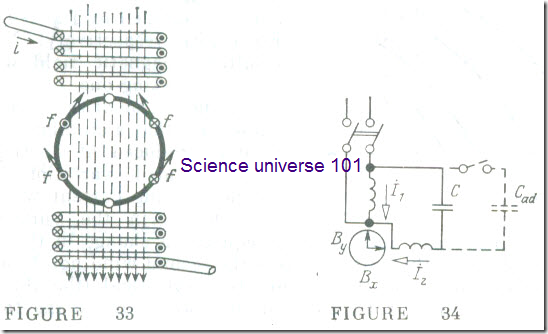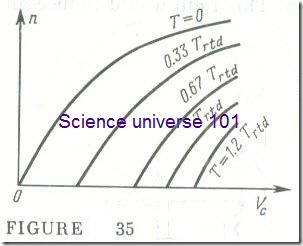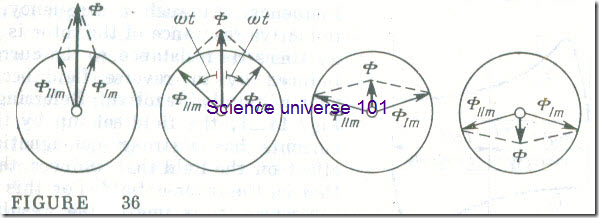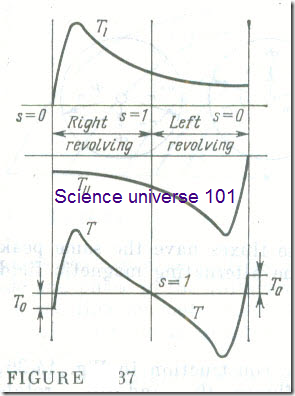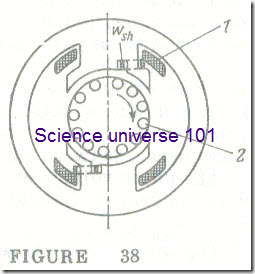Two-Phase and Single-Phase Induction Motors
In an induction motor with only one single-phase winding on the stator (Fig 33), the applied alternating current would excite an alternating magnetic field whose axis would remain stationary so long as its rotor remains stationary, too. This field would induce an emf in the rotor winding, giving rise to rotor currents. The interaction of the rotor currents with the stator field would give rise to electromagnetic forces f acting in opposite directions in the right- and left-hand halves of the rotor. As a consequence, the resultant torque acting on the rotor would be zero. Thus, with only one single-phase winding, the breakaway (initial starting) torque in a single-phase motor would be zero which implies that such a motor could not start rotating on its own.
Two methods are used to produce the breakaway torque in motors powered from a single-phase supply line. Accordingly, it is usual to class them into two-phase and single-phase.
Two-phase induction motors. In addition to a winding connected directly to the supply line, there is a second winding which is connected to a phase-shifting device which may be a capacitor or an inductor. The better choice is a capacitor (Fig 34) for which reason we have a capacitor-start induction motor. The stator slots of a capacitor-start motor hold two phase windings each of which takes up half the total number of slots. This serves to produce the starting torque by the induction mechanism (see Sec. 12.9), that is, by use of two alternating magnetic fluxes displaced from each other in both space and time phase.
It is best to use a circular rotating magnetic field, and it can be obtained in a two-phase motor. With such an arrangement one has, however, to choose when to excite such a field and, as a consequence, a maximum torque-at starting or at rated load.
The point is that if the currents in the stator windings, İ1 and I2, have the same rms value and are in phase quadrature with each other, the magnetic field they set up will have two components, B and By, defined by Eq. (14.2) and Eq. (14.3), respectively. Now the resultant magnetic field will be a circular rotating one.
If the value of the capacitor is chosen so that a circular magnetic field is produced at starting, then at rated load variations in the second-winding current would cause a change in the voltage drop across the capacitor and, as a consequence a change in the magnitude and phase in the voltage across the second winding. As a result, the rotating magnetic field would turn elliptical (the flux would be pulsating during rotation), and this would cause the torque to decrease.
This limitation can be circumvented by disconnecting some of the capacitors in going from the start-up to normal running (the respective connections are shown dashed in Fig 34). This reduction in capacitance can be effected automatically by a centrifugal switch when the motor has come to 75-80 % of its rated speed, or by a time relay.
Two-phase induction motors are also used in automatic control applications as controlled motors: their speed or torque are varied by adjusting the rms value or phase of the voltage impressed on one of the windings. Instead of a conventional squirrel-cage rotor, such motors have a rotor in the form of a hollow thin-walled aluminium cylinder (called the drag cup) rotating in a narrow air gap between the stator and a stationary laminated-iron core. Such a drag-cup motor (as it is usually called) has a negligible inertia which is especially important in some process control applications. A plot of speed versus control voltage for a drag-cup motor is shown in Fig. Fig 35.
Single-phase induction motors cannot develop any breakaway (initial starting) torque by themselves. If, however, the rotor is set spinning by some external force in any direction, the motor will then keep rotating on its own and develop a considerable torque.
Similar conditions are produced in a three-phase motor when the fuse in anyone phase has blown-the motor will keep running on a single-phase supply. The only precaution that needs to be made is to keep the load to not over 50-60% of the rated value so as to avoid overheating in the remaining two phase windings.
The operation of a single-phase motor may be explained by considering its alternating magnetic field as one produced by the superposition of two magnetic fields rotating in opposite directions at
a constant angular velocity ɷ/p, These fluxes have the same peak value, ΦIm = ΦIIm , equal to half the alternating magnetic field of the machine
ΦIm = ΦIIm = Φm /2
As is seen from the simple graphic construction in Fig 36, the superposition of the two identical fluxes, ΦIm and ΦIIm, rotating in opposite directions, results in a magnetic flux which varies sinusoidally .
Φ = Φm sin ɷt
In a single-phase motor this condition holds so long as the rotor is stationary.
From the assumption that the resultant alternating magnetic field arises from the superposition of rotating fields, we may conclude that these two fields produce identical currents in the rotor winding. Interacting with the rotating fields, the rotor currents develop two identical torques acting in opposite directions and cancelling each other.
This equality of two torques is upset when the rotor is set spinning by an external force in any direction. Now the torque produced by the forward field (that is, one rotating with the rotor) substantially exceeds the torque developed by the reverse field (that is one rotating against the rotor). As a result, the rotor can not only rotate on its own, but also drive some mechanism.
The reduction in the opposing torque when the rotor is revolving is due to the weakening of the reverse field. With respect to the reverse field the slip of the rotor is
sII = ( n1 + n )/n1 = [n1 + n1 (1 – sI )]/n1 = 2 – sI (14.36)
where sI is the slip of the rotor relative to the forward field.
Equation (14.36) shows that the frequency of the currents induced in the rotor by the reverse field is close to twice the supply-line frequency. At such a frequency, the inductive reactance of the rotor is many times its resistance, so the currents induced by the reverse field become nearly purely reactive. Referring to Fig 21, the field set up by these currents has a strong demagnetizing effect on the field that induces them, that is, the reverse field. For this reason when 81 is small, the resultant magnetic field of the machine becomes a nearly circular rotating field and the opposing torque due to the reverse field is negligible.
For each of the two fields, we may apply the already known torque-slip curves of the usual three-phase induction motor and find the resultant torque T as the difference between the forward torque, TI , and the reverse torque, TII (Fig 37). An important property of a single-phase motor is that it develops a small negative torque T0 when the rotor is revolving at synchronous speed relative to the forward field.
In a single-phase motor, an increase in the forward-field slip sI brings about. not only an increase in the current I1 induced by the forward field, but also an increase in the opposing torque associated with the reverse field. Because of this, a Single-phase induction motor is less stable in operation than a three-phase one, and its maximum torque is substantially lower. Also the efficiency of a single-phase induction motor is lower than that of a three-phase unit due to a number of stray losses.
One needs an auxiliary device in order to start a single-phase induction motor. Most of ton, this is an auxiliary winding similar to the second winding of a two-phase motor, but disconnected from the supply line once the motor has been started because it is designed for a short-duration load current. This auxiliary winding is connected in series with a phase-shifting device.
Shaded-pole induction motors. In one particular case the starting device of a single-phase motor may be left energized after starting and during normal running. This case refers to shaded-pole induction motors which may be looked upon as standing midway between single-phase and two-phase induction motors (Fig 38).
In this type of motor, one side of each stator pole carrying the main (primary) winding 1 is enclosed by a solid ring of copper or brass called a shading ring or coil wsh The current I1 in the stator winding 1 which is energized from the supply line sets up a magnetic flux Φ1 . Some of this flux threads the shading coil and induces in it a current, I2 , substantially lagging in phase behind I1 This current excites a second magnetic flux so that a system of two alternating fluxes exists in the motor, displaced from each other both in space and time phase. This situation is not unlike that existing in the induction type of instrument movement (see Fig 23). This gives rise to a rotating magnetic field which interacts with the cage rotor 2 and develops a torque. Shaded-pole motors come in fractional horsepower ratings (0.5-30 W) and are widely used to actuate a large variety of final control elements.

